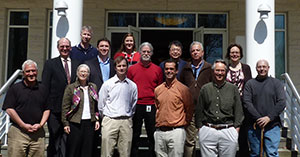By Michael Lucibella

COE - April 2013
The standards were in part inspired by the Common Core set of standards for math and language arts which have been adopted by more than forty states. The science standards were first released in April and so far three states have adopted them while others are in the process of considering them.
"My guess is more than half of the states will have adopted the standards in a couple of years," said Helen Quinn of SLAC, who chaired the National Research Council's Board on Science Education which helped author the standards.
Authors of the standards point out that though many state boards of education have expressed an interest in the NGSS, it is neither a national set of standards nor mandatory. States can voluntarily adopt or reject the standards.
"The Next Generation Science Standards is a project to get states hooked together on their expectations for learning science," said Paul Cottle, chair of the APS Committee on Education. "They're appropriate for setting topics that every student should know."
The National Research Council, the National Science Teachers Association, the American Association for the Advancement of Science and the educational nonprofit Achieve worked together to develop the standards along with representatives of 26 state boards of education. The Carnegie Institute of New York helped fund the effort.
The standards are composed of a number of "performance expectations" that students should be able to achieve. Such expectations emphasize teaching how science works and what scientists do rather than a list of scientific facts and equations.
"It's a whole shift in thinking about what standards are and what they are not," Quinn said.
The aim of the standards is to set a minimum bar for students to understand the scientific process after graduating from high school. The standards are not for students who have taken a physics-specific course, as many states don't require more than two years of basic science.
Textbook manufacturers in particular have been supportive of the effort because it is easier to print textbooks that conform to a broadly adopted set of standards than to the amalgam of disparate state standards that exists today.
"There are many ways in which scientists working with teachers could help the implementation phase," Quinn said, adding that the APS involement in teacher training is one way that the Society can help states adopt the standards. "Adoption is one step; implementation doesn't happen overnight."
Education standards have historically been a controversial idea. Oftentimes state boards of education object to the idea of having national standards imposed on them, which is why the Next Generation standards are voluntary and have been organized with much input from states.
In addition, some boards find the content of some of the standards objectionable.
"There's always the issue of evolution, and there are people who aren't happy that there's the issue of anthropogenic effect on climate," said Ramon Lopez, a professor at the University of Texas at Arlington. "We're not trying to preach to students, we're asking them to evaluate the evidence."
Though the physics community has been generally positive towards the standards, some concerns have been raised within that the standards aren't expansive enough.
"Breadth versus depth has been the ongoing tension in the process," Cottle said. "As physicists we naturally favor a much deeper understanding."
Writers of the standards said that coming up with a final version was a balancing act.
"They are by no means perfect," said Lopez, "but I think it would be very difficult to do a whole lot better."
©1995 - 2024, AMERICAN PHYSICAL SOCIETY
APS encourages the redistribution of the materials included in this newspaper provided that attribution to the source is noted and the materials are not truncated or changed.
Staff Science Writer: Michael Lucibella
August/September 2013 (Volume 22, Number 8)
Articles in this Issue


